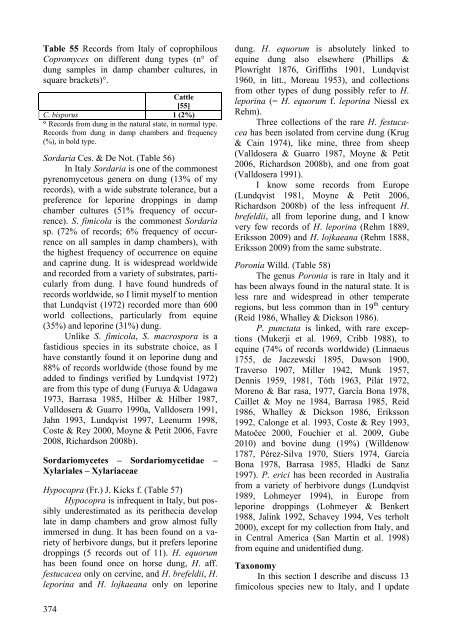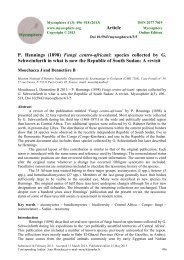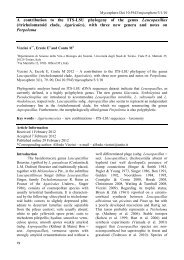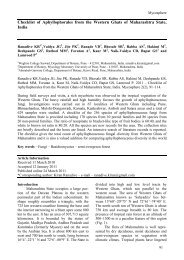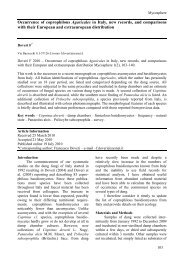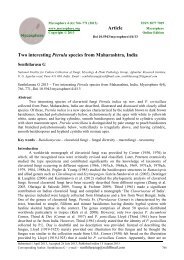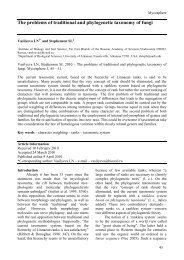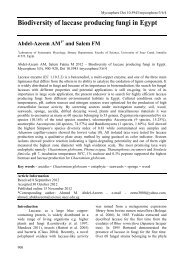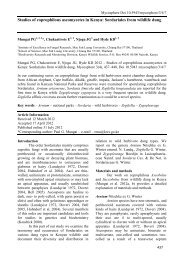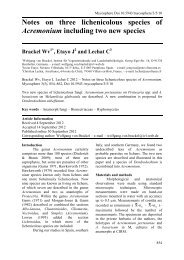Fungi Fimicoli Italici - Mycosphere-online journal
Fungi Fimicoli Italici - Mycosphere-online journal
Fungi Fimicoli Italici - Mycosphere-online journal
Create successful ePaper yourself
Turn your PDF publications into a flip-book with our unique Google optimized e-Paper software.
Table 55 Records from Italy of coprophilous<br />
Copromyces on different dung types (n° of<br />
dung samples in damp chamber cultures, in<br />
square brackets)°.<br />
Cattle<br />
[55]<br />
C. bisporus 1 (2%)<br />
° Records from dung in the natural state, in normal type.<br />
Records from dung in damp chambers and frequency<br />
(%), in bold type.<br />
Sordaria Ces. & De Not. (Table 56)<br />
In Italy Sordaria is one of the commonest<br />
pyrenomycetous genera on dung (13% of my<br />
records), with a wide substrate tolerance, but a<br />
preference for leporine droppings in damp<br />
chamber cultures (51% frequency of occurrence).<br />
S. fimicola is the commonest Sordaria<br />
sp. (72% of records; 6% frequency of occurrence<br />
on all samples in damp chambers), with<br />
the highest frequency of occurrence on equine<br />
and caprine dung. It is widespread worldwide<br />
and recorded from a variety of substrates, particularly<br />
from dung. I have found hundreds of<br />
records worldwide, so I limit myself to mention<br />
that Lundqvist (1972) recorded more than 600<br />
world collections, particularly from equine<br />
(35%) and leporine (31%) dung.<br />
Unlike S. fimicola, S. macrospora is a<br />
fastidious species in its substrate choice, as I<br />
have constantly found it on leporine dung and<br />
88% of records worldwide (those found by me<br />
added to findings verified by Lundqvist 1972)<br />
are from this type of dung (Furuya & Udagawa<br />
1973, Barrasa 1985, Hilber & Hilber 1987,<br />
Valldosera & Guarro 1990a, Valldosera 1991,<br />
Jahn 1993, Lundqvist 1997, Leenurm 1998,<br />
Coste & Rey 2000, Moyne & Petit 2006, Favre<br />
2008, Richardson 2008b).<br />
Sordariomycetes – Sordariomycetidae –<br />
Xylariales – Xylariaceae<br />
Hypocopra (Fr.) J. Kicks f. (Table 57)<br />
Hypocopra is infrequent in Italy, but possibly<br />
underestimated as its perithecia develop<br />
late in damp chambers and grow almost fully<br />
immersed in dung. It has been found on a variety<br />
of herbivore dungs, but it prefers leporine<br />
droppings (5 records out of 11). H. equorum<br />
has been found once on horse dung, H. aff.<br />
festucacea only on cervine, and H. brefeldii, H.<br />
leporina and H. lojkaeana only on leporine<br />
374<br />
dung. H. equorum is absolutely linked to<br />
equine dung also elsewhere (Phillips &<br />
Plowright 1876, Griffiths 1901, Lundqvist<br />
1960, in litt., Moreau 1953), and collections<br />
from other types of dung possibly refer to H.<br />
leporina (= H. equorum f. leporina Niessl ex<br />
Rehm).<br />
Three collections of the rare H. festucacea<br />
has been isolated from cervine dung (Krug<br />
& Cain 1974), like mine, three from sheep<br />
(Valldosera & Guarro 1987, Moyne & Petit<br />
2006, Richardson 2008b), and one from goat<br />
(Valldosera 1991).<br />
I know some records from Europe<br />
(Lundqvist 1981, Moyne & Petit 2006,<br />
Richardson 2008b) of the less infrequent H.<br />
brefeldii, all from leporine dung, and I know<br />
very few records of H. leporina (Rehm 1889,<br />
Eriksson 2009) and H. lojkaeana (Rehm 1888,<br />
Eriksson 2009) from the same substrate.<br />
Poronia Willd. (Table 58)<br />
The genus Poronia is rare in Italy and it<br />
has been always found in the natural state. It is<br />
less rare and widespread in other temperate<br />
regions, but less common than in 19 th century<br />
(Reid 1986, Whalley & Dickson 1986).<br />
P. punctata is linked, with rare exceptions<br />
(Mukerji et al. 1969, Cribb 1988), to<br />
equine (74% of records worldwide) (Linnaeus<br />
1755, de Jaczewski 1895, Dawson 1900,<br />
Traverso 1907, Miller 1942, Munk 1957,<br />
Dennis 1959, 1981, Tóth 1963, Pilát 1972,<br />
Moreno & Bar rasa, 1977, García Bona 1978,<br />
Caillet & Moy ne 1984, Barrasa 1985, Reid<br />
1986, Whalley & Dickson 1986, Eriksson<br />
1992, Calonge et al. 1993, Coste & Rey 1993,<br />
Matočec 2000, Fouchier et al. 2009, Gube<br />
2010) and bovine dung (19%) (Willdenow<br />
1787, Pérez-Silva 1970, Stiers 1974, García<br />
Bona 1978, Barrasa 1985, Hladki de Sanz<br />
1997). P. erici has been recorded in Australia<br />
from a variety of herbivore dungs (Lundqvist<br />
1989, Lohmeyer 1994), in Europe from<br />
leporine droppings (Lohmeyer & Benkert<br />
1988, Jalink 1992, Schavey 1994, Ves terholt<br />
2000), except for my collection from Italy, and<br />
in Central America (San Martín et al. 1998)<br />
from equine and unidentified dung.<br />
Taxonomy<br />
In this section I describe and discuss 13<br />
fimicolous species new to Italy, and I update


